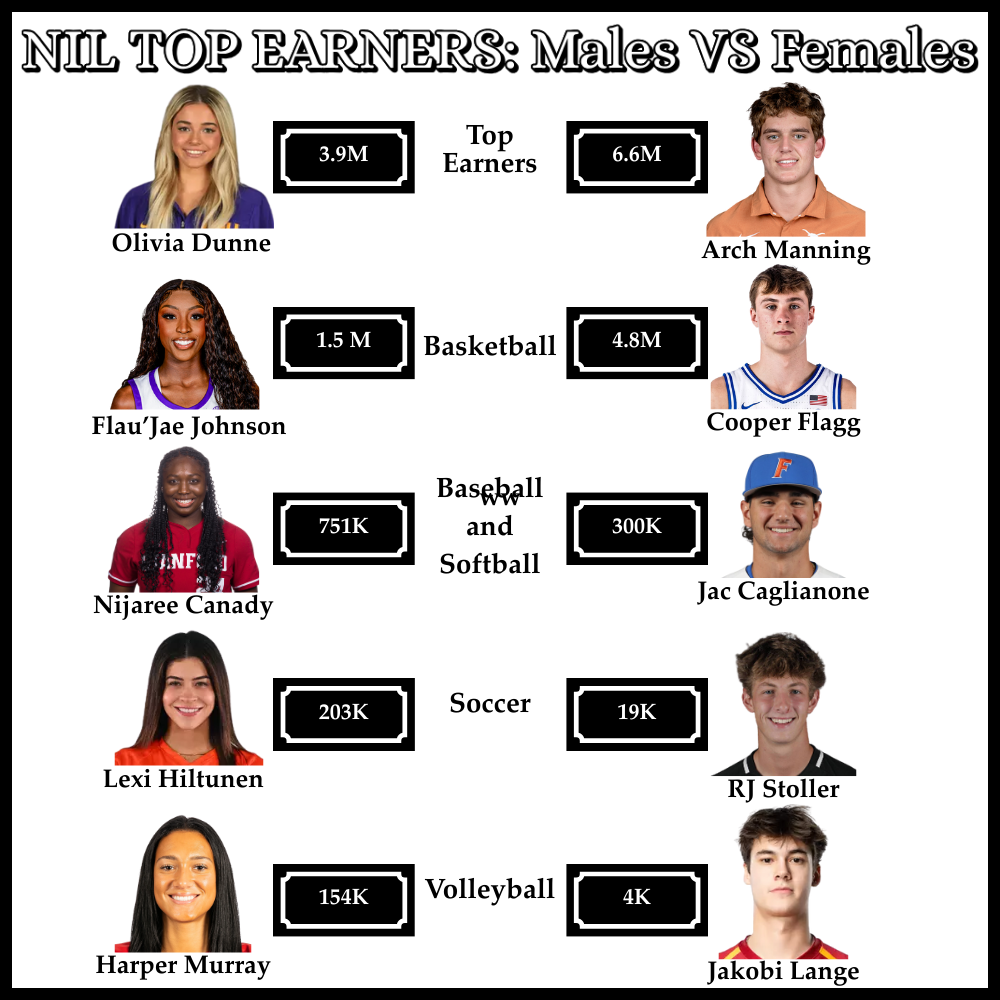
NIL Men vs Women Pay in College Athletics
By: Victoria Carmona
The introduction of NIL (Name, Image, and Likeness) rights has transformed college sports by allowing athletes to profit from their brands. However, a major gender gap persists. Male athletes earn significantly more, while female athletes, despite strong social media followings and athletic success, lag in earnings.
At twelve schools reporting NIL earnings by gender, male athletes brought in $92 million compared to $19 million for female athletes, according to On3. At Texas A&M, 98% of NIL deals benefit mens sports. These disparities reflect broader institutional practices that favor male athletes.
“You have to ask yourself why this happens. The numbers do not lie. There is a clear preference for male athletes. Womens sports are often overlooked, even though they have proven their value,” said West Broward Athletic Director Allison Edens.
LSU gymnast Livvy Dunne is the top-earning female athlete in NIL, ranking #4 overall with $3.9 million annually and 5.3 million Instagram followers. Yet, she trails behind male athletes like Arch Manning, who earns $6.5 million with just 387k followers. The next highest-earning female athlete, Flau’jae Johnson, ranks #44 with $1.5 million, highlighting a persistent gender pay gap.
Supporters of the current system often cite revenue. “Pay rates are based on how much money the team brings in. Professional mens basketball teams bring in hundreds of millions, if not billions, more than the female teams. So if it is linearly adjusted, female sports do not bring in as much money,” said Edens.
Male-dominated sports like football and basketball receive the most media coverage, fan support, and sponsorship. While women’s sports gain visibility, female athletes still struggle to secure endorsement deals, despite large followings.
“As in television, you are starting to see more womens sports. There is a new professional soccer league starting. Softball launched a professional league. People enjoy watching womens basketball, sometimes more than the NBA, because it is tougher. But college football still dominates TV,” said West Broward Head Football Coach Bryan McCartney.
Title IX, passed in 1972, mandates equal treatment of male and female athletes in school sports. But that goal remains elusive. For instance, the Utah Crimson Collective gifted 85 male football players $61,000 Dodge trucks, excluding female athletes. Critics argue such disparities undercut the intent of Title IX.
“They will not be held accountable. College football and basketball make so much more money from NIL. I do not think it will ever get people paid equally. Unless you are a top-notch womens program, like South Carolina basketball, it will not be regulated,” said McCartney.
Some institutions are working to close the gap. Butler University partnered with 29 companies to support its women’s basketball team. Howard University launched an initiative in March 2025, hosting an event with 100 influential women in sports and business to support female athletes through the Mecca Made NIL Collective.
“It is just going to depend on outside sponsorships and their willingness to find the equity and morality in paying women closer to what men make. There is no clear answer. But it is a domino effect, someone has to bite the bullet and try,” stated Edens.
High school athletes are also navigating the evolving NIL world. Alivia Artanis, a standout softball player at West Broward High School, shared her experience. “We are working just as hard, but it feels like we do not get the same chances to make big deals,” she said. “It is disappointing, especially since we have strong social media followings. You see male athletes getting massive deals, but for women, it is a different story.”
Achieving equity in NIL earnings requires more than a policy change, it demands a cultural shift. Female athletes need not only visibility but also genuine financial support.
“The gap in NIL earnings is not just about sport. It is about equal recognition and opportunity. If we truly believe in gender equality, then it is time to start seeing it in the numbers,” said Edens.



Average Rating